一、SpringBoot介绍
1.1 Spring缺点分析

Spring是一个非常优秀的轻量级框架,以IOC(控制反转)和AOP(面向切面)为思想内核,极大简化了JAVA企业级项目的开发。
虽然Spring的组件代码是轻量级的,但它的配置却是重量级的。使用Spring进行项目开发需要在配置文件中写很多代码,所有这些配置都代表了开发时的损耗。
除此之外,Spring项目的依赖管理也是一件耗时耗力的事情。在环境搭建时,需要分析要导入哪些库的坐标,而且还需要分析导入与之有依赖关系的其他库的坐标,一旦选错了依赖的版本,随之而来的不兼容问题就会严重阻碍项目的开发进度。比如Spring5.0以上只能使用Junit4.12以上的版本。
总结
Spring的缺点:
- 配置过于繁琐。
- 引入的依赖过多,版本控制复杂。
1.2 什么是SpringBoot

SpringBoot对Spring的缺点进行改善和优化,基于约定大于配置的思想,简化了Spring的开发,所谓简化是指简化了Spring中大量的配置文件和繁琐的依赖引入,提供了大量的默认配置。所以SpringBoot是一个服务于框架的框架,它不是对Spring功能的增强,而是提供了一种快速使用Spring框架的方式。
SpringBoot的优点:
- 配置简单
- 依赖引入简单
- 提供了一些大型项目的非功能特性,如嵌入式服务器,安全指标,健康监测等。
1.3 SpringBoot核心功能

自动配置
SpringBoot项目自动提供最优配置,同时可以修改默认值满足特定的要求。
起步依赖
SpringBoot的依赖是基于功能的,而不是普通项目的依赖是基于JAR包的。SpringBoot将完成一个功能所需要的所有坐标打包到一起,并完成了版本适配,我们在使用某功能时只需要引入一个依赖即可。
二、SpringBoot入门
2.1 通过IDEA脚手架搭建项目

1、在IDEA中新建项目,项目类型为Spring Initializr,选择JDK版本和搭建网站后点击下一步。

2、选择项目参数后,点击下一步
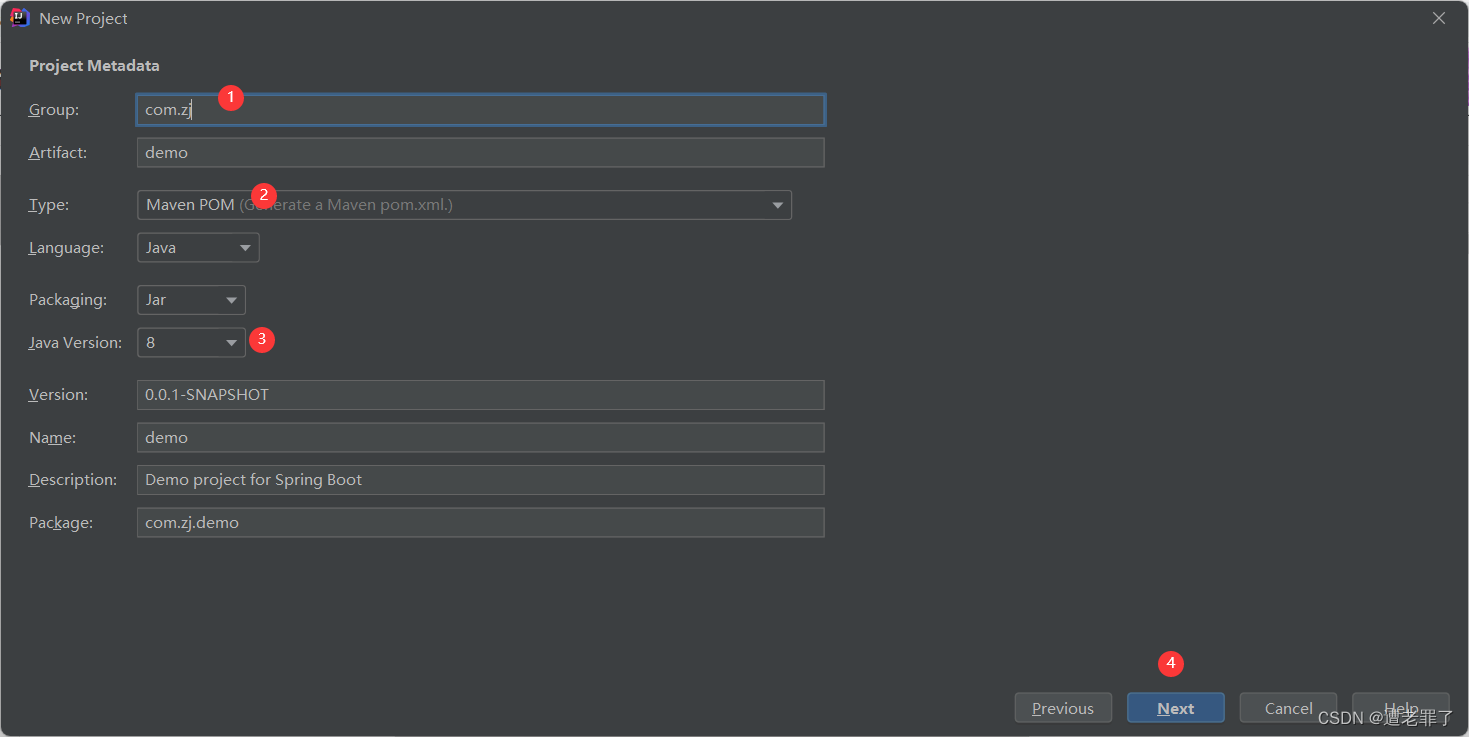
3、选择SpringBoot版本和需要的起步依赖,点击下一步。

4、确定项目位置完成项目搭建

注意:如果是jdk8最好创建的spring boot的版本是2.xxxx。
2.2 SpringBoot项目结构

POM文件
1、SpringBoot项目必须继承spring-boot-starter-parent,即所有的SpringBoot项目都是spring-boot-starter-parent的子项目。spring-boot-starter-parent中定义了常用配置、依赖、插件等信息,供SpringBoot项目继承使用。
<parent>
<groupId>org.springframework.boot</groupId>
<artifactId>spring-boot-starter-parent</artifactId>
<version>3.1.0</version>
<relativePath/> <!-- lookup parent from repository -->
</parent>
2、SpringBoot项目中可以定义起步依赖,起步依赖不是以jar包为单位,而是以功能为单位。
<dependencies>
<dependency>
<groupId>org.springframework.boot</groupId>
<artifactId>spring-boot-starter-web</artifactId>
</dependency>
<dependency>
<groupId>org.springframework.boot</groupId>
<artifactId>spring-boot-starter-test</artifactId>
<scope>test</scope>
</dependency>
</dependencies>
3、spring-boot-maven-plugin插件是将项目打包成jar包的插件。该插件打包后的SpringBoot项目无需依赖web容器,可以直接使用JDK运行
<build>
<plugins>
<plugin>
<groupId>org.springframework.boot</groupId>
<artifactId>spring-boot-maven-plugin</artifactId>
</plugin>
</plugins>
</build>
启动类
启动类的作用是启动SpringBoot项目,运行启动类的main方法即可启动SpringBoot项目。在运行web项目的时候可以将项目放到内置的tomcat中运行,不需要使用外置的tomcat。
package com.zj.demo;
import org.springframework.boot.SpringApplication;
import org.springframework.boot.autoconfigure.SpringBootApplication;
@SpringBootApplication
public class DemoApplication {
public static void main(String[] args) {
SpringApplication.run(DemoApplication.class, args);
}
}
配置文件
由于SpringBoot极大简化了Spring配置,所以只有一个application.properties配置文件,且Spring的自动配置功能使得大部分的配置都有默认配置,该文件的功能是覆盖默认配置信息,该文件不写任何信息都可以启动项目。
2.3 编写JAVA代码

之前搭建的SpringBoot项目已经都整合了SpringMVC,我们编写一个控制器进行测试:
@Controller
public class MyController {
@RequestMapping("/hello")
@ResponseBody
public String hello(){
System.out.println("hello springboot!");
return "hello springboot!";
}
}
启动类在启动时会做注解扫描(@Controller、@Service、@Repository......),扫描位置为同包或者子包下的注解,所以我们要在启动类同级或同级包下编写代码。

三、SpringBoot原理分析
3.1 起步依赖

查看spring-boot-starter-parent起步依赖
1、按住
Ctrl
点击
pom.xml
中的
spring-boot-starter-parent
,跳转到了
spring-boot-starter-parent
的
pom.xml
,发现
spring-boot-starter-parent
的父工程是
spring-boot-dependencies
。
如果在pom文件中ctrl键突然失效了,无法查看源码,那可能是没有下载文档。
3.2 自动配置
3.3 核心注解
四、SpringBoot注册Web组件
4.1 注册servlet(有了controller谁还用servlet)

由于SpringBoot项目没有web.xml文件,所以无法在web.xml中注册web组件,SpringBoot有自己的方式注册web组件。
注册方式一
1、编写servlet
@WebServlet("/first")
public class FirstServlet extends HttpServlet {
public void doGet(HttpServletRequest request, HttpServletResponse response){
System.out.println("First Servlet........");
}
}
2、启动类扫描web组件
@WebServlet("/first")
public class FirstServlet extends HttpServlet {
public void doGet(HttpServletRequest request, HttpServletResponse response){
System.out.println("First Servlet........");
}
}
注册方式二
1、编写servlet
public class SecondServlet extends HttpServlet {
public void doGet(HttpServletRequest request, HttpServletResponse response){
System.out.println("Second Servlet........");
}
}
2、使用配置类注册servlet
@Configuration
public class ServletConfig {
//ServletRegistrationBean可以注册Servlet组件,将其放入Spring容器中即可注册Servlet
@Bean
public ServletRegistrationBean getServletRegistrationBean(){
// 注册Servlet组件
ServletRegistrationBean bean = new ServletRegistrationBean(new SecondServlet());
// 添加Servlet组件访问路径
bean.addUrlMappings("/second");
return bean;
}
}
4.2 注册Filter

注册方式一
1、编写filter
//过滤的是first请求
@WebFilter(urlPatterns = "/first")
public class FirstFilter implements Filter {
public void init(FilterConfig filterConfig) throws ServletException { }
@Override
public void doFilter(ServletRequest servletRequest, ServletResponse servletResponse, FilterChain filterChain) throws IOException, ServletException, IOException {
System.out.println("进入First Filter");
filterChain.doFilter(servletRequest,servletResponse);
System.out.println("离开First Filter");
}
@Override
public void destroy() { }
}
2、启动类扫描web组件
@SpringBootApplication
//SpringBoot启动时扫描注册@WebServlet、@WebFilter注解标注的Web组件
@ServletComponentScan
public class DemoApplication {
public static void main(String[] args) {
SpringApplication.run(DemoApplication.class, args);
}
}
注册方式二
1、编写filter
@Configuration
public class FilterConfig {
@Bean
public FilterRegistrationBean getFilterRegistrationBean(){
// 注册filter组件
FilterRegistrationBean bean = new FilterRegistrationBean(new SecondFilter());
// 添加过滤路径
bean.addUrlPatterns("/second");
return bean;
}
}
4.3 注册Listener

注册方式一
1、编写Listener
这里选择注册上下文监听器
@WebListener
public class FirstListener implements ServletContextListener {
@Override
public void contextInitialized(ServletContextEvent sce) {
System.out.println("First Listener Init......");
}
@Override
public void contextDestroyed(ServletContextEvent sce) {
}
}
2、启动类扫描web组件
@SpringBootApplication
//SpringBoot启动时扫描注册@WebServlet、@WebFilter、@WebListener注解标注的Web组件
@ServletComponentScan
public class DemoApplication {
public static void main(String[] args) {
SpringApplication.run(DemoApplication.class, args);
}
}
注册方式二
1、编写Listener
public class SecondListener implements ServletContextListener {
@Override
public void contextInitialized(ServletContextEvent sce) {
System.out.println("Second Listener Init......");
}
@Override
public void contextDestroyed(ServletContextEvent sce) {
}
}
2、使用配置类注册Listener
@Configuration
public class ListenerConfig {
@Bean
public ServletListenerRegistrationBean getServletListenerRegistrationBean(){
ServletListenerRegistrationBean bean = new ServletListenerRegistrationBean(new SecondListener());
return bean;
}
}
五、SpringBoot访问静态资源
5.1 静态资源相关目录

SpringBoot项目中没有WebApp目录,只有src目录。在
src/main/resources
下面有
static
和
templates
两个文件夹。SpringBoot默认在
static
目录中存放静态资源,而
templates
中放动态页面。
static目录
SpringBoot通过
/resources/static
目录访问静态资源,在
resources/static
中编写html页面:
1、html页面
<!DOCTYPE html>
<html lang="en">
<head>
<meta charset="UTF-8">
<title>测试html</title>
</head>
<body>
<h1>我的HTML</h1>
<img src="/img/img.png">
</body>
</html>
2、目录结构

templates目录
在SpringBoot中不推荐使用JSP作为动态页面,而是默认使用Thymeleaf编写动态页面。templates目录是存放Thymeleaf页面的目录,稍后。
5.2 静态资源其他存放位置

除了
/resources/static
目录,SpringBoot还会扫描以下位置的静态资源:
- /resources/META‐INF/resources/
- /resources/resources/
- /resources/public/
我们还可以在配置文件自定义静态资源位置,例如在resources目录下创建suibian文件:

在SpringBoot配置文件进行自定义静态资源位置配置:
spring:
web:
resources:
static-locations: classpath:/suibian/,classpath:/static/
注意:
- 该配置会覆盖默认静态资源位置,如果还想使用之前的静态资源位置,还需要配置在后面。
- SpringBoot2.5之前的配置方式为:
spring.resources.static-locations
六、Thymeleaf

6.1 Thymeleaf入门
Thymeleaf是一款用于渲染XML/HTML5内容的模板引擎,类似JSP。它可以轻易的与SpringMVC等Web框架进行集成作为Web应用的模板引擎。在SpringBoot中推荐使用Thymeleaf编写动态页面。
Thymeleaf最大的特点是能够直接在浏览器中打开并正确显示模板页面,而不需要启动整个Web应用。
Thymeleaf在有网络和无网络的环境下皆可运行,它即可以让美工在浏览器查看页面的静态效果,也可以让程序员在服务器查看带数据的动态页面效果。没有数据时,Thymeleaf的模板可以静态地运行;当有数据返回到页面时,Thymeleaf标签会动态地替换掉静态内容,使页面动态显示。
1、创建springboot项目,并选择添加的依赖。

2、在template目录编写html页面
<!DOCTYPE html>
<!-- 引入thymeleaf命名空间,方便使用thymeleaf属性 -->
<html lang="en" xmlns:th="http://www.thymeleaf.org">
<head>
<meta charset="UTF-8">
<title>thymeleaf入门</title>
</head>
<body>
<!-- 静态页面显示默认信息,动态页面使用后端传来的msg数据代替 -->
<!-- thymeleaf支持el表达式 -->
<h2 th:text="${msg}">默认信息</h2>
</body>
</html>
需要注意的是使用thyme leaf需要在html页面中添加 <html lang="en" xmlns:th="http://www.thymeleaf.org">
thymeleaf语法检查比较严格,有些时候写对了还是爆红,我们只需要将语法检查取消就行了:
3、template中的动态html文件不能直接访问,需要编写Controller跳转到页面中
@Controller
public class PageController {
// 页面跳转,无返回值时默认跳转到和访问路径相同的页面。
@GetMapping("/index")
public void showPage(Model model){
model.addAttribute("msg","Hello Thymeleaf");
}
}
4、启动项目,访问http://localhost:8080/index

6.2 变量输出

语法作用th:text将model中的值作为内容放入标签中(其实就是request域中的数据,session、application域中的数据都行)th:value将model中的值放入
input
标签的
value
属性中
1、准备模型数据
// 页面跳转,无返回值时默认跳转到和访问路径相同的页面。
@GetMapping("/index")
public void showPage(HttpServletRequest model){
model.setAttribute("msg","Hello Thymeleaf");
}
2、在视图展示model中的值
<h2 th:text="${msg}">默认信息</h2>
<input th:value="${msg}">
3、 启动项目,访问http://localhost:8080/index

6.3 操作字符串

Thymeleaf提供了一些内置对象可以操作数据,内置对象可直接在模板中使用,这些对象是以#引用的,操作字符串的内置对象为strings。
方法说明${#strings.isEmpty(key)}判断字符串是否为空,如果为空返回true,否则返回false${#strings.contains(msg,'T')}判断字符串是否包含指定的子串,如果包含返回true,否则返回false${#strings.startsWith(msg,'a')}判断当前字符串是否以子串开头,如果是返回true,否则返回false${#strings.endsWith(msg,'a')}判断当前字符串是否以子串结尾,如果是返回true,否则返回false${#strings.length(msg)}返回字符串的长度${#strings.indexOf(msg,'h')}查找子串的位置,并返回该子串的下标,如果没找到则返回-1${#strings.substring(msg,2,5)}截取子串,用法与JDK的
subString
方法相同${#strings.toUpperCase(msg)}字符串转大写${#strings.toLowerCase(msg)}字符串转小写
1、html
<span th:text="${#strings.isEmpty(msg)}"></span><!--判空-->
<br>
<span th:text="${#strings.contains(msg,'s')}"></span><!--包含-->
<br>
<span th:text="${#strings.toUpperCase(msg)}"></span><!--转大写-->
2、控制器
// 页面跳转,无返回值时默认跳转到和访问路径相同的页面。
@GetMapping("/index")
public void showPage(HttpServletRequest model){
model.setAttribute("msg","Hello Thymeleaf");
}
3、访问

6.4 操作时间

操作时间的内置对象为dates
方法说明${#dates.format(key)}格式化日期,默认的以浏览器默认语言为格式化标准${#dates.format(key,'yyyy/MM/dd')}按照自定义的格式做日期转换${#dates.year(key)}取年${#dates.month(key)}取月${#dates.day(key)}取日
1、html
<span th:text="${#dates.format(date)}"></span><!--按照浏览器的格式转换时间-->
<br>
<span th:text="${#dates.format(date,'yyyy-MM-dd')}"></span><!--按照给定格式转换时间-->
<br>
<span th:text="${#dates.year(date)}"></span><!--获取年-->
<br>
<span th:text="${#dates.month(date)}"></span><!--获取月份-->
<br>
<span th:text="${#dates.day(date)}"></span><!--获取天-->
2、控制器
// 页面跳转,无返回值时默认跳转到和访问路径相同的页面。
@GetMapping("/index")
public void showPage(Model model){
//Date参数:130表示距离1900后30年也就是2030年
model.addAttribute("date",new Date(130,1,1));
}
3、访问

6.5 条件判断
语法作用th:if条件判断
1、html
<span th:if="${sex}== '女'">
性别:女
</span>
<span th:if="${sex} == '男'">
性别:男
</span>
2、控制器
// 页面跳转,无返回值时默认跳转到和访问路径相同的页面。
@GetMapping("/index")
public void showPage(Model model){
model.addAttribute("sex","女");
}
3、访问

语法作用th:switch/th:caseth:switch/th:case与Java中的switch语句等效。
th:case="*"
表示Java中switch的default,即没有case的值为true时显示
th:case="*"
的内容。
1、html
<div th:switch="${id}">
<span th:case="1">ID为1</span>
<span th:case="2">ID为2</span>
<span th:case="3">ID为3</span>
<span th:case="*">ID为*</span>
</div>
2、控制器
// 页面跳转,无返回值时默认跳转到和访问路径相同的页面。
@GetMapping("/index")
public void showPage(Model model){
model.addAttribute("id","12");
}
3、访问

6.6 遍历集合

语法作用th:each迭代器,用于循环迭代集合
1、pojo
public class User {
private String id;
private String name;
private int age;
//get/set/构造略
}
2、控制器
// 页面跳转,无返回值时默认跳转到和访问路径相同的页面。
@GetMapping("/index")
public void showPage(Model model){
List<User> users = new ArrayList<>();
users.add(new User("1","谷梦琪",23));
users.add(new User("2","邴梓童",22));
users.add(new User("3","孔新月",25));
model.addAttribute("users",users);
}
3、html
<table border="1" width="50%">
<tr>
<th>ID</th>
<th>Name</th>
<th>Age</th>
</tr>
<!-- 遍历集合的每一项起名为user -->
<tr th:each="user : ${users}">
<td th:text="${user.id}"></td>
<td th:text="${user.name}"></td>
<td th:text="${user.age}"></td>
</tr>
</table>
4、访问

6.7 遍历时使用状态变量

thymeleaf将遍历的状态变量封装到一个对象中,通过该对象的属性可以获取状态变量:
状态变量含义index当前迭代器的索引,从0开始count当前迭代对象的计数,从1开始size被迭代对象的长度odd/even布尔值,当前循环是否是偶数/奇数,从0开始first布尔值,当前循环的是否是第一条,如果是返回true,否则返回falselast布尔值,当前循环的是否是最后一条,如果是则返回true,否则返回false
1、html
<table border="1" >
<!--冒号前的第一个对象是遍历出的对象,第二个对象是封装状态变量的对象-->
<tr th:each="user,status : ${users}">
<td th:text="${user.id}"></td>
<td th:text="${user.name}"></td>
<td th:text="${user.age}"></td>
<td th:text="${status.index}"></td>
<td th:text="${status.count}"></td>
<td th:text="${status.size}"></td>
<td th:text="${status.odd}"></td>
<td th:text="${status.even}"></td>
<td th:text="${status.first}"></td>
<td th:text="${status.last}"></td>
</tr>
</table>
2、控制器
// 页面跳转,无返回值时默认跳转到和访问路径相同的页面。
@GetMapping("/index")
public void showPage(Model model){
List<User> users = new ArrayList<>();
users.add(new User("1","谷梦琪",23));
users.add(new User("2","邴梓童",22));
users.add(new User("3","孔新月",25));
model.addAttribute("users",users);
}
3、访问

6.8 遍历map

1、控制器
// 页面跳转,无返回值时默认跳转到和访问路径相同的页面。
@GetMapping("/index")
public void showPage(Model model){
Map<String,User> map = new HashMap<>();
map.put("user1",new User("1","谷梦琪",23));
map.put("user2",new User("2","邴梓童",22));
map.put("user3",new User("3","孔新月",25));
model.addAttribute("map",map);
}
2、html
<table border="1" width="50%">
<tr>
<th>ID</th>
<th>Name</th>
<th>Age</th>
<th>Key</th>
</tr>
<!-- 遍历出的是一个键值对对象,key获取键,value获取值 -->
<tr th:each="m : ${map}">
<td th:text="${m.value.id}"></td>
<td th:text="${m.value.name}"></td>
<td th:text="${m.value.age}"></td>
<td th:text="${m.key}"></td>
</tr>
</table>
3、访问

6.9 获取域中的数据

thymeleaf也可以获取request,session,application域中的数据,方法如下:
1、控制器
// 页面跳转,无返回值时默认跳转到和访问路径相同的页面。
@GetMapping("/index")
public void showPage(HttpServletRequest request, HttpSession session){
request.setAttribute("req","HttpServletRequest");
session.setAttribute("ses","HttpSession");
session.getServletContext().setAttribute("app","application");
}
2、html
<!--第一种,使用内置对象request获取request对象的方法-->
<span th:text="${#request.getAttribute('req')}"></span>
<!--第二种,使用httpServletRequest内置对象获取数据-->
<span th:text="${#httpServletRequest.getAttribute('req')}"></span>
<hr>
<!--第一种获取session数据-->
<span th:text="${session.ses}"></span>
<!--第二种使用内置对象获取数据-->
<span th:text="${#httpSession.getAttribute('ses')}"></span>
<hr>
<!--第一种获取application对象的方法-->
<span th:text="${application.app}"></span>
<!--第二种使用内置对象获取数据-->
<span th:text="${#servletContext.getAttribute('app')}"></span>
3、访问

6.10 URL写法

在Thymeleaf中路径的写法为
@{路径}
<a th:href="@{http://www.baidu.com}">百度</a>
静态传参
1、控制器
//访问index.html
@RequestMapping("/index")
public void index(){ }
// 返回json格式的数据
@GetMapping("/show")
@ResponseBody
public String showPage(String id,String name){
return id + "-" + name;
}
2、html
<a th:href="@{show?id=1&name='张三'}">静态传参1</a>
<a th:href="@{show(id=2,name=lisi)}">静态传参2</a>
动态传参
1、控制器
//访问index.html
@RequestMapping("/index")
public void index(Model model){
model.addAttribute("id",1);
model.addAttribute("name", "张三 ");
}
// 返回json格式的数据
@GetMapping("/show")
@ResponseBody
public String showPage(String id,String name){
return id + "-" + name;
}
2、html
<a th:href="@{'show?id='+${id}+'&name='+${name}}">动态传参1</a>
<a th:href="@{show(id=${id},name=${name})}">动态传参2</a>
6.11 RESTful风格URL写法
1、控制器
//访问index.html
@RequestMapping("/index")
public void index(Model model){
model.addAttribute("id",1);
model.addAttribute("name", "张三 ");
}
// restful风格
@GetMapping("/show/{id}/{name}")
@ResponseBody
public String showPage(@PathVariable String id, @PathVariable String name){
return id + "-" + name;
}
2、html
<a th:href="@{show/{id}/{name}(id=${id},name=${name})}">restful风格传参</a>
6.12 Thymeleaf相关配置

在Springboot配置文件中可以进行Thymeleaf相关配置,但是一般不需要配置,使用默认的就行
配置项含义spring.thymeleaf.prefix视图前缀spring.thymeleaf.suffix视图后缀spring.thymeleaf.encoding编码格式spring.thymeleaf.servlet.content-type响应类型spring.thymeleaf.cache=false页面缓存,配置为false则不启用页面缓存,方便测试
spring:
thymeleaf:
prefix: classpath:/templates/
suffix: .html
encoding: UTF-8
cache: false
servlet:
content-type: text/html
七、SpringBoot热部署

热部署,就是在应用正在运行的时候升级软件,却不需要重新启动应用。即修改完代码后不需要重启项目即可生效。在SpringBoot中,可以使用DevTools工具实现热部署
1、添加DevTools依赖
<!-- 热部署工具 -->
<dependency>
<groupId>org.springframework.boot</groupId>
<artifactId>spring-boot-devtools</artifactId>
<optional>true</optional>
</dependency>
2、在idea中设置自动编译
点击
File-->Settings
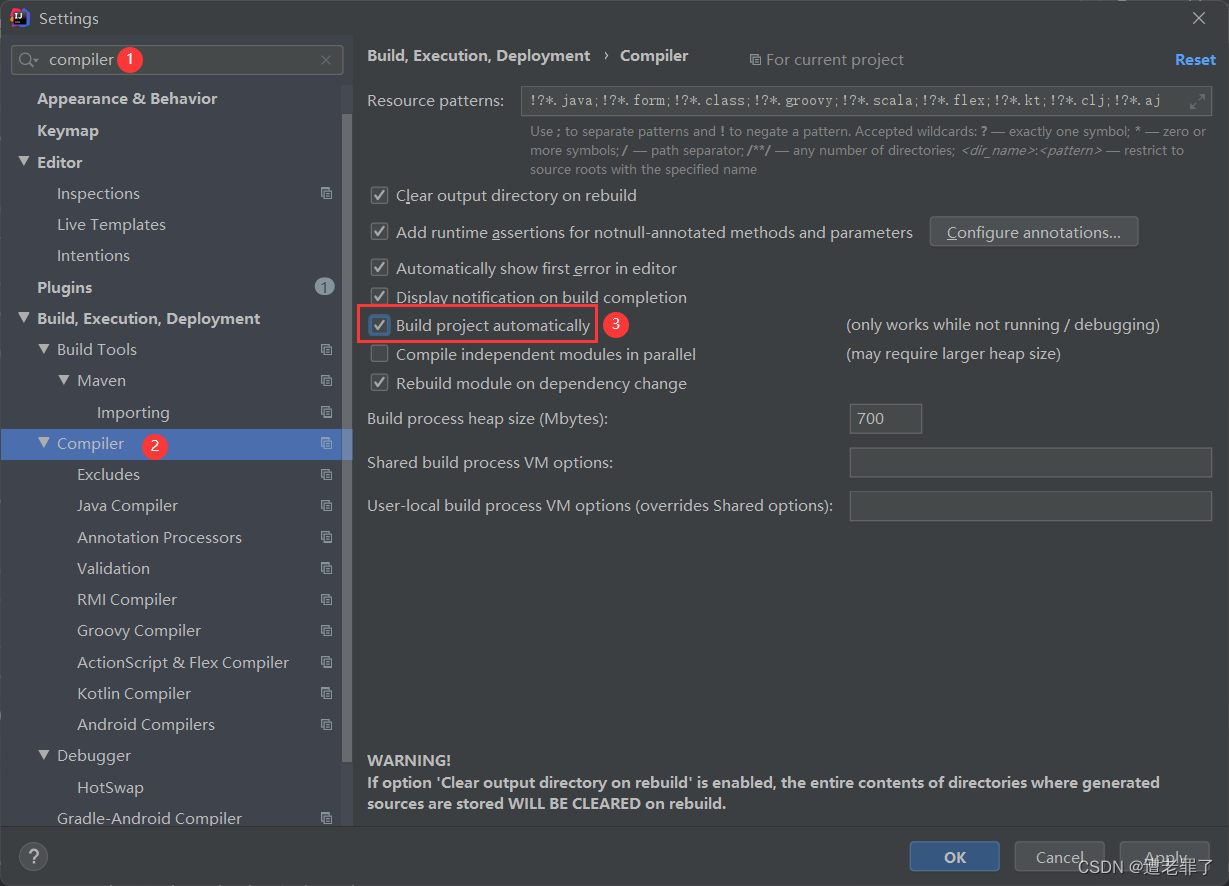
3、在Idea设置自动运行
快捷键
Ctrl+Shift+Alt+/
后点击
Registry
,勾选
complier.automake.allow.when.app.running

八、SpringBoot整合Mybatis

Spring整合MyBatis时需要进行大量配置,而SpringBoot整合MyBatis则可以简化很多配置:
1、准备数据库
2、创建SpringBoot项目,添加MyBatis起步依赖和Mysql驱动依赖
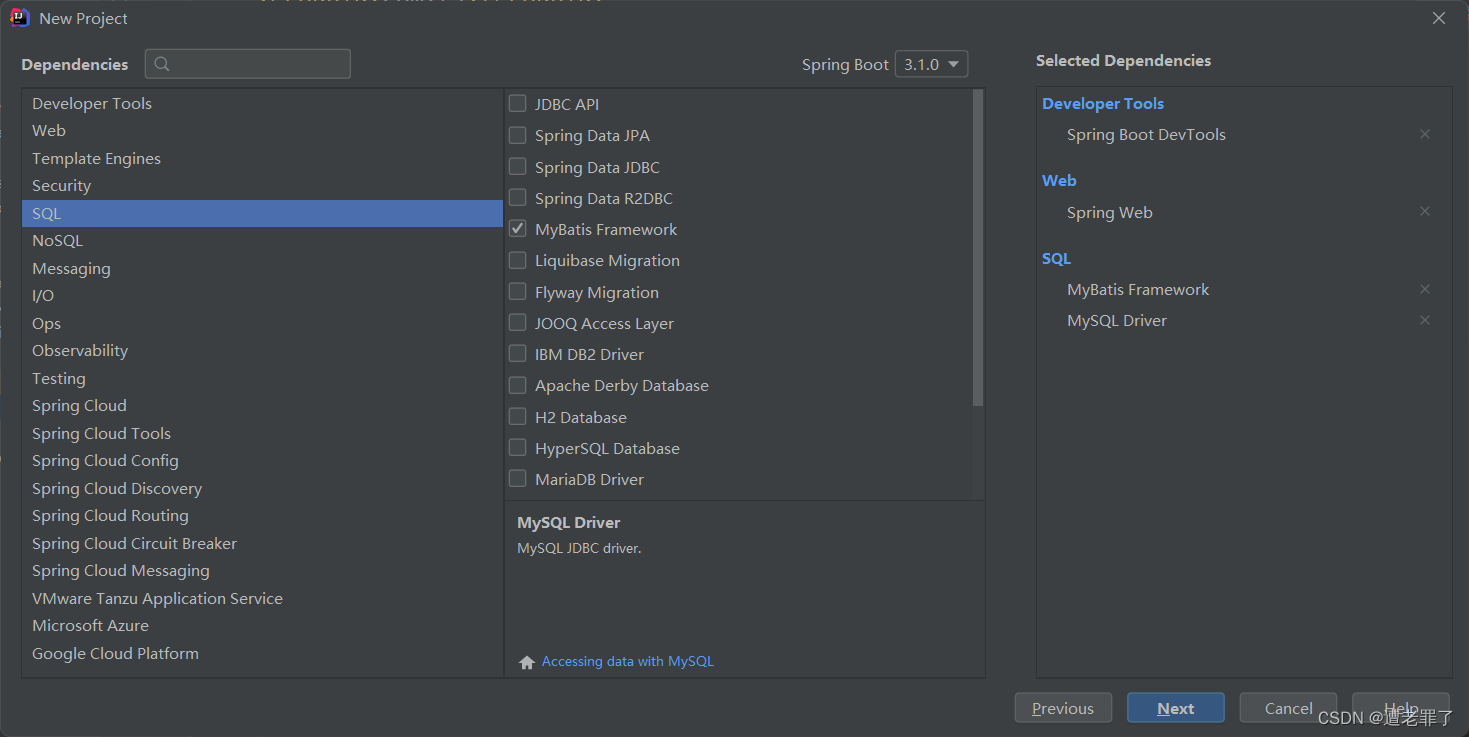
3、编写实体类
public class User {
private int id;
private String username;
private String sex;
private String address;
private int account;
}
4、编写Mapper接口
@Mapper
public interface UserMapper {
List<User> findUsers();
}
5、在resources目录下编写mapper映射文件(接口和映射文件所在的文件的路径保持一致,并且映射文件所在的目录文件要一级一级建)
<?xml version="1.0" encoding="UTF-8"?>
<!DOCTYPE mapper
PUBLIC "-//mybatis.org//DTD Mapper 3.0//EN"
"http://mybatis.org/dtd/mybatis-3-mapper.dtd">
<mapper namespace="com.zj.mapper.UserMapper">
<select id="findUsers" resultType="com.zj.pojo.User">
select * from user;
</select>
</mapper>
6、编写配置文件
#数据源
spring:
datasource:
driver-class-name: com.mysql.cj.jdbc.Driver
url: jdbc://mysql:///mybatis?serverTimezone=UTC
username: root
password: 123456
mybatis:
#Mybatis配置映射文件的位置
mapper-locations: com/zj/mapper/*Mapper.xml
#实体类起别名
type-aliases-package: com.zj.pojo
#日志格式
logging:
pattern:
console: '%d{HH:mm:ss.SSS} %clr(%-5level) --- [%-15thread] %cyan(%-50logger{50}):%msg%n'
7、编写测试类
package com.zj.mapper;
import com.zj.mapper.UserMapper;
import com.zj.pojo.User;
import org.junit.jupiter.api.Test;
import org.springframework.boot.test.context.SpringBootTest;
import javax.annotation.Resource;
import java.util.List;
@SpringBootTest //springboot测试类注解,在运行测试代码时加载容器
public class UserMapperTest {
@Resource
private UserMapper userMapper;
@Test
public void testUsers(){
List<User> users = userMapper.findUsers();
for (User user : users) {
System.out.println(user);
}
}
}

九、参SpringBoot参数校验
9.1 校验简单数据类型

SpringBoot自带了validation工具可以从后端对前端传来的参数进行校验,用法如下:
1、引入
validation
起步依赖,或者在创建项目的时候引入该模块。

2、控制器
@Controller
@Validated //该控制器开启参数校验
public class TestController {
@RequestMapping("/test1")
@ResponseBody
//在参数校验,表示该参数不为空。当参数为空时会报异常
public String test1(@NotBlank(message = "用户名不能为空") String name){
return "test1:"+name;
}
}
9.2 异常处理

当抛出
ConstraintViolationException
异常后,我们可以使用SpringMVC的异常处理器,也可以使用SpringBoot自带的异常处理机制。
当程序出现了异常,SpringBoot会使用自带的
BasicErrorController
对象处理异常。该处理器会默认跳转到/resources/templates/error.html页面()。
1、引入依赖,在参数校验的基础上还需要thymeleaf依赖。
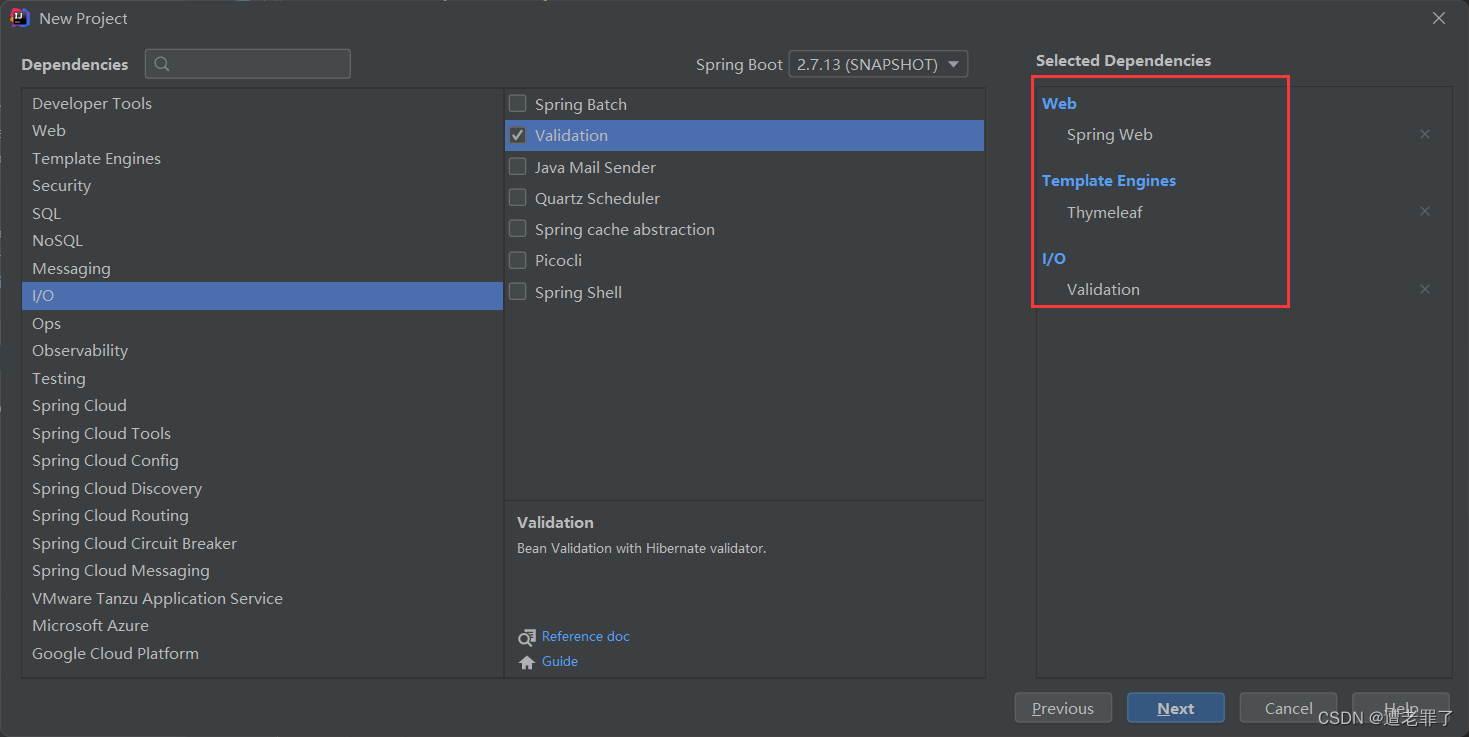
2、编写错误页面
<!DOCTYPE html>
<html lang="en">
<head>
<meta charset="UTF-8">
<title>错误页面</title>
</head>
<body>
只要出现异常都会跳转到该页面
<h1>服务器开小差了!</h1>
</body>
</html>
3、控制器
@Controller
@Validated //该控制器开启参数校验
public class TestController {
@RequestMapping("/test1")
@ResponseBody
//在参数校验,表示该参数不为空。当参数为空时会报异常
public String test1(@NotBlank(message = "用户名不能为空") String name){
return "test1:"+name;
}
}
4、访问

9.3 校验相关注解
注解作用@NotNull判断包装类是否为null@NotBlank判断字符串是否为null或者是空串(去掉首尾空格)@NotEmpty判断集合是否为空(在判断泛型是基本数据类型的时候还需要加@RequestParam)@Length判断字符的长度(最大或者最小)@Min判断数值最小值@Max判断数值最大值@Email判断邮箱是否合法
1、控制器
package com.zj.controller;
import org.hibernate.validator.constraints.Length;
import org.springframework.stereotype.Controller;
import org.springframework.validation.annotation.Validated;
import org.springframework.web.bind.annotation.RequestMapping;
import org.springframework.web.bind.annotation.RequestParam;
import org.springframework.web.bind.annotation.ResponseBody;
import javax.validation.constraints.*;
import java.util.List;
@Controller
@Validated //该控制器开启参数校验
public class TestController {
@RequestMapping("/test1")
@ResponseBody
//在参数校验,表示该参数不为空。当参数为空时会报异常
public String test1(@NotBlank(message = "用户名不能为空")
@Length(min = 1,max = 5) String name,
@NotNull @Min(1) @Max(100) Integer age,
@NotEmpty @RequestParam List<String> address,
@NotBlank @Email String email){
return "请求成功";
}
}
2、访问

9.3 校验对象类型

SpringBoot也可以校验对象参数中的每个属性,用法如下:
1、添加实体类
public class Student {
@NotNull(message = "id不能为空")
private Integer id;
@NotBlank(message = "姓名不能为空")
private String name;
// 省略getter/setter/tostring
}
2、控制器
@RequestMapping("/test2")
@ResponseBody
// 校验的对象参数前添加@Validated,并将异常信息封装到BindingResult对象中
public String t3(@Validated Student student, BindingResult result) {
// 判断是否有参数异常
if (result.hasErrors()) {
// 所有参数异常
List<ObjectError> list = result.getAllErrors();
// 遍历参数异常,输出异常信息
for (ObjectError err : list) {
FieldError fieldError = (FieldError) err;
System.out.println(fieldError.getDefaultMessage());
}
return "参数异常";
}
System.out.println(student);
return "请求成功!";
}
3、访问

十、SpringBoot指标监控
10.1 添加Actuator功能

Spring Boot Actuator可以帮助程序员监控和管理SpringBoot应用,比如健康检查、内存使用情况统计、线程使用情况统计等。我们在SpringBoot项目中添加Actuator功能,即可使用Actuator监控项目,用法如下:
1、在被监控的项目中添加Actuator起步依赖
<dependency>
<groupId>org.springframework.boot</groupId>
<artifactId>spring-boot-starter-actuator</artifactId>
</dependency>
2、编写配置文件
#开启所有监控端点
management.endpoints.web.exposure.include=*
3、访问项目:http://localhost:8080/actuator
通过URL可以调用actuator的功能:
URL查看的数据/env环境属性/health健康检查/mappings显示所有的@RequestMapping路径/loggers日志/info定制信息/metrics查看内存、CPU核心等系统参数/trace用户请求信息
例如查询健康数据,访问http://localhost:8080/actuator/health
10.2 创建SpringBootAdmin服务端项目

Actuator使用JSON格式展示了大量指标数据,不利于我们查看,我们可以使用可视化工具Spring Boot Admin查看actuator生成指标数据。Spring Boot Admin是一个独立的项目,我们需要创建并运行该项目。
1、创建SpringBoot项目,添加SpringMVC和Spring Boot Admin服务端起步依赖
2、修改配置文件
# 端口号
server.port=8081
#日志格式
logging.pattern.console=%d{HH:mm:ss.SSS} %clr(%-5level) --- [%-15thread] %cyan(%-50logger{50}):%msg%n
3、修改启动类
@SpringBootApplication
@EnableAdminServer //开启Spring Boot Admin服务端
public class DemoApplication {
public static void main(String[] args) {
SpringApplication.run(DemoApplication.class, args);
}
}
10.3 连接SpringBootAdmin项目
在被监控的项目中连接Spring Boot Admin项目,才能使用Spring Boot Admin查看指标数据。
1、被监控项目添加Spring Boot Admin客户端起步依赖
<dependency>
<groupId>de.codecentric</groupId>
<artifactId>spring-boot-admin-starter-client</artifactId>
<version>2.6.0</version>
</dependency>
2、修改配置文件
#连接服务端
spring.boot.admin.client.url=http://localhost:8081
此时Spring Boot Admin即可连接被监控的项目

十一、SpringBoot日志管理

11.1 logback日志配置
SpringBoot默认使用Logback组件作为日志管理。Logback是log4j创始人设计的一个开源日志组件。在SpringBoot项目中我们不需要额外的添加Logback的依赖,因为在
spring-boot-parent
中已经包含了Logback的依赖。
1、在
/resources
下添加Logback配置文件logback.xml
<?xml version="1.0" encoding="UTF-8" ?>
<configuration>
<!--定义日志文件的存储地址-->
<property name="LOG_HOME" value="${catalina.base}/logs/"/>
<!-- 控制台输出 -->
<appender name="Stdout" class="ch.qos.logback.core.ConsoleAppender">
<!-- 日志输出编码 -->
<layout class="ch.qos.logback.classic.PatternLayout">
<!--格式化输出:%d表示日期,%thread表示线程名,%-5level:级别从左显示5个字符宽度%msg:日志消息,%n是换行符-->
<pattern>%d{MM-dd HH:mm:ss.SSS} [%thread] %-5level %logger{50} - %msg%n
</pattern>
</layout>
</appender>
<!-- 按照每天生成日志文件 -->
<appender name="RollingFile" class="ch.qos.logback.core.rolling.RollingFileAppender">
<rollingPolicy class="ch.qos.logback.core.rolling.TimeBasedRollingPolicy">
<!--日志文件输出的文件名-->
<FileNamePattern>${LOG_HOME}/server.%d{yy99-MM-dd}.log</FileNamePattern>
<MaxHistory>30</MaxHistory>
</rollingPolicy>
<layout class="ch.qos.logback.classic.PatternLayout">
<!--格式化输出:%d表示时间,%thread表示线程名,%-5level:级别从左显示5个字符宽度%msg:日志消息,%n是换行符-->
<pattern>%d{HH:mm:ss.SSS} [%thread] %-5level %logger{50} - %msg%n
</pattern>
</layout>
<!--日志文件最大的大小-->
<triggeringPolicy class="ch.qos.logback.core.rolling.SizeBasedTriggeringPolicy">
<MaxFileSize>10MB</MaxFileSize>
</triggeringPolicy>
</appender>
<!-- 日志输出级别 -->
<root level="info">
<appender-ref ref="Stdout"/>
<appender-ref ref="RollingFile"/>
</root>
</configuration>
注:Logback配置文件名为logback-test.xml或logback.xml,如果classpath下没有这两个文件,LogBack会自动进行最小化配置。
2、在代码中打印日志
package com.zj.controller;
import org.slf4j.Logger;
import org.slf4j.LoggerFactory;
import org.springframework.stereotype.Controller;
import org.springframework.web.bind.annotation.RequestMapping;
import org.springframework.web.bind.annotation.ResponseBody;
@Controller
public class LogController {
private final static Logger logger = LoggerFactory.getLogger(LogController.class);
@RequestMapping("/log")
@ResponseBody
public String showLogMessage(){
//每次访问在控制台、日志文件中输出日志
logger.info("记录日志:logMessage方法执行");
return "hello Logback";
}
}
3、访问

如果日志过多,可以屏蔽一些包的日志,在配置文件中配置
#屏蔽org包中的日志输出
logging.level.org=off
11.2 log4j2安全漏洞
补充:Log4j2安全漏洞
在2021年12月,Log4j2爆出了极其严重的安全漏洞,攻击者可以让记录的日志包含指定字符串,从而执行任意程序。很多大型网站,如百度等都是此次Log4j漏洞的受害者,很多互联网企业连夜做了应急措施。
Log4j2.0到2.14.1全部存在此漏洞,危害范围极其广泛,Log4j2.15.0-rc1中修复了这个 bug。
因Log4j2漏洞的反复无常,导致某些公司已经切换到Logback来记录日志,但在Log4j2漏洞爆出后,Logback也爆出漏洞:在Logback1.2.7及之前的版本中,具有编辑配置文件权限的攻击者可以制作恶意配置,允许从LDAP服务器加载、执行任意代码。
解决方案为将Logback升级到安全版本:
Logback1.2.9+SpringBoot2.6.2以上的Logback版本已经升到了1.2.9,Log4j2的版本也升到了2.17.0,所以我们使用SpringBoot2.6.2以上版本无需担心Log4j2和Logback安全漏洞。
十二、SpringBoot项目部署
12.1 项目打包

SpringBoot项目是依赖于Maven构建的,但打包时如果只依赖Maven打包工具则会打包不完整,我们还需要在SpringBoot项目中引入SpringBoot打包插件 ,有些版本是自动带着该插件的。
<build>
<plugins>
<plugin>
<groupId>org.springframework.boot</groupId>
<artifactId>spring-boot-maven-plugin</artifactId>
</plugin>
</plugins>
</build>
如果加上这个插件仍无法打包的话再加上下面的这个插件:
<plugin>
<groupId>org.apache.maven.plugins</groupId>
<artifactId>maven-resources-plugin</artifactId>
<!--修改版本-->
<version>3.1.0</version>
</plugin>

打包好的jar在target目录下:

运行jar包:
- 进入jar包所在目录,使用cmd打开命令行窗口
- 输入命令:java -jar jar包名

12.2 多环境配置

在真实开发中,在不同环境下运行项目往往会进行不同的配置,比如开发环境使用的是开发数据库,测试环境使用的是测试数据库,生产环境使用的是生产数据库。SpringBoot支持不同环境下使用不同的配置文件,用法如下:
配置文件名:
application-环境名.properties/yml
1、application-dev.properties/yml 开发环境配置文件
# 开发环境端口号为8080 server: port: 80802、application-test.properties/yml 测试环境配置文件
# 测试环境端口号为8081 server: port: 80813、application-prod.properties/yml 生产环境配置文件
# 生产环境端口号为80 server: port: 80运行jar包时选择环境:
java -jar jar包名 --spring.profiles.active=环境名
十三、SpringBoot容器化部署
13.1 安装docker环境
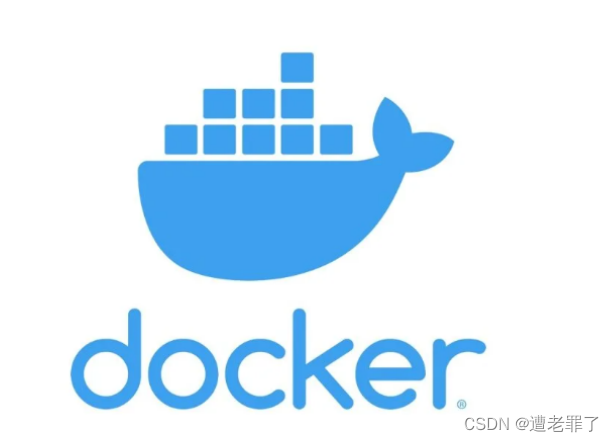
为了节约资源,在生产环境中我们更多的是使用Docker容器部署SpringBoot应用,首先我们准备Docker环境:
1、准备一台centos7系统的虚拟机,连接虚拟机。
2、关闭虚拟机防火墙
# 关闭运行的防火墙
systemctl stop firewalld.service
# 禁止防火墙自启动
systemctl disable firewalld.service
13.2 Dockerfile制作镜像
由于在SpringBoot中嵌入了Web容器,所以在制作SpringBoot项目的镜像时无需依赖Web容器,基于JDK制作镜像即可,接下来我们使用Dockerfile制作镜像:
1、进入opt目录
cd /opt
2、使用rz命令(或者xftp)将项目Jar包上传至虚拟机
使用rz前提是下载lrsz,yum -y install lrzsz
3、编写DockerFile
# 基于JDK11
FROM openjdk:8
# 作者
MAINTAINER zj
# 拷贝到容器opt目录
ADD sb_logback.jar /opt
#保留端口
EXPOSE 8080
# 启动容器后执行的命令
CMD java -jar /opt/sb_logback.jar
4、构建镜像
docker build -t sb_logback .
5、查看所有的镜像,出现springbootdocker代表镜像构建成功

6、使用镜像创建并启动容器
docker run -d -p 8080:8080 sb_logback
7、访问查看是否启动成功

13.3 Maven插件制作镜像
除了DockerFile,我们还可以使用Maven插件制作镜像。使用方法如下:
1、开启远程docker服务
# 修改docker配置文件
vim /lib/systemd/system/docker.service
# 在ExecStart=后添加配置,远程访问docker的端口为2375
ExecStart=/usr/bin/dockerd-current -H tcp://0.0.0.0:2375 -H unix://var/run/docker.sock \
--add-runtime docker-runc=/usr/libexec/docker/docker-runc-current \
--default-runtime=docker-runc \
--exec-opt native.cgroupdriver=systemd \
--userland-proxy-path=/usr/libexec/docker/docker-proxy-current \
--init-path=/usr/libexec/docker/docker-init-current \
--seccomp-profile=/etc/docker/seccomp.json \
$OPTIONS \
$DOCKER_STORAGE_OPTIONS \
$DOCKER_NETWORK_OPTIONS \
$ADD_REGISTRY \
$BLOCK_REGISTRY \
$INSECURE_REGISTRY \
$REGISTRIES
# 重启docker
systemctl daemon-reload
systemctl restart docker
2、在项目的pom文件中添加
docker-maven-plugin
插件
<!-- docker-maven-plugin-->
<plugin>
<groupId>com.spotify</groupId>
<artifactId>docker-maven-plugin</artifactId>
<version>1.2.2</version>
<configuration>
<!-- Docker路径 -->
<dockerHost>http://192.168.25.101:2375</dockerHost>
<!-- Dockerfile定义 -->
<baseImage>openjdk:8</baseImage>
<!-- 作者 -->
<maintainer>zj</maintainer>
<resources>
<resource>
<!-- 复制jar包到docker容器指定目录 -->
<targetPath>/opt</targetPath>
<!-- 从哪个包拷贝文件,target包 -->
<directory>${project.build.directory}</directory>
<!-- 拷贝哪个文件 -->
<include>${project.build.finalName}.jar</include>
</resource>
</resources>
<workdir>/</workdir>
<entryPoint>["java", "-jar", "${project.build.finalName}.jar","--spring.profiles.active=dev"]</entryPoint>
<forceTags>true</forceTags>
<!-- 镜像名 -->
<imageName>${project.artifactId}</imageName>
<!-- 镜像版本 -->
<imageTags>
<imageTag>${project.version}</imageTag>
</imageTags>
</configuration>
</plugin>
3、使用maven的package命令给项目打包
4、使用maven的docker插件制作镜像
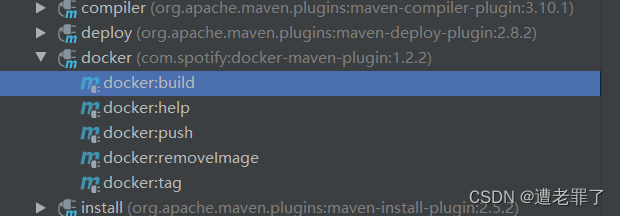
5、查看所有的镜像

6、创建并访问容器

十四、Spring Task

定时任务即系统在特定时间执行一段代码,它的场景应用非常广泛:
- 购买游戏的月卡会员后,系统每天给会员发放游戏资源。
- 管理系统定时生成报表。
- 定时清理系统垃圾。
- ......
定时任务的实现主要有以下几种方式:
- Java自带的java.util.Timer类,这个类允许调度一个java.util.TimerTask任务。使用这种方式可以让程序按照某一个频度执行,但不能在指定时间运行。一般用的较少。
- Quartz。这是一个功能比较强大的的调度器,可以让程序在指定时间执行,也可以按照某一个频度执行,配置起来稍显复杂。
- Spring3.0以后自带Spring Task,可以将它看成一个轻量级的Quartz,使用起来比 Quartz简单许多,在课程中我们使用Spring Task实现定时任务
14.1 入门案例
1、创建SpringBoot项目,在启动类开启定时任务。
@SpringBootApplication
@EnableScheduling //开启定时任务
public class DemoApplication {
public static void main(String[] args) {
SpringApplication.run(DemoApplication.class, args);
}
}
2、编写定时任务类
@Component
public class MyTask {
//定时方法,每秒实行一次
@Scheduled(cron="* * * * * *")
public void task1(){
//当前时间
System.out.println("当前时间:"+new SimpleDateFormat("yyyy-MM-dd HH:mm:ss").format(new Date()));
}
}
3、运行

14.2 Cron表达式

Spring Task依靠Cron表达式配置定时规则。Cron表达式是一个字符串,分为6或7个域,每一个域代表一个含义,以空格隔开。有如下两种语法格式:
Seconds ``````MinutesHoursDayofMonthMonthDayofWeekYearSecondsMinutesHoursDayofMonthMonthDayofWeek
Seconds(秒):域中可出现 **,
-*/**四个字符,以及0-59的整数
*:表示匹配该域的任意值,在Seconds域使用*,表示每秒钟都会触发,:表示列出枚举值。在Seconds域使用5,20,表示在5秒和20秒各触发一次。@Scheduled(cron="5,15,30,40 * * * * *") //每分钟的第5,15,30,40秒执行一次
-:表示范围。在Seconds域使用5-20,表示从5秒到20秒每秒触发一次@Scheduled(cron="5-20 * * * * *") //定时方法,每分钟的第5到20秒执行
/:表示起始时间开始触发,然后每隔固定时间触发一次。在Seconds域使用5/20, 表示5秒触发一次,25秒,45秒分别触发一次。@Scheduled(cron="5/10 * * * * *")//定时方法,在当前分钟的第5开始执行,每间隔10秒执行一次
Minutes(分):域中可出现
,-*/四个字符,以及0-59的整数
Hours(时):域中可出现
,-*/四个字符,以及0-23的整数
DayofMonth(日期):域中可出现
,-*/?LWC八个字符,以及1-31的整数
C:表示和当前日期相关联。在DayofMonth域使用5C,表示在5日后的那一天触发,且每月的那天都会触发。比如当前是10号,那么每月15号都会触发。@Scheduled(cron="0 0 0 5c * * *")//今天是1号,那么本月的6号0点和以后每月的6号0点都执行
L:表示最后,在DayofMonth域使用L,表示每个月的最后一天触发。@Scheduled(cron="0 0 0 L * * *")//本月的最后一天0点执行
W:表示工作日,在DayofMonth域用15W,表示最接近这个月第15天的工作日触发,如果15号是周六,则在14号即周五触发;如果15号是周日,则在16号即周一触发;如果15号是周二则在当天触发。注:1. 该用法只会在当前月计算,不会到下月触发。比如在DayofMonth域用31W,31号是周日,那么会在29号触发而不是下月1号。2. 在DayofMonth域用LW,表示这个月的最后一个工作日触发。
Month(月份):域中可出现
,-*/四个字符,以及1-12的整数或JAN-DEC的单词缩写
@Scheduled(cron="0 0 0 * 6-8 * *")//6-8月每天晚上的0点执行
DayofWeek(星期):可出现
,-*/?L#C八个字符,以及1-7的整数或SUN-SAT 单词缩写,1代表星期天,7代表星期六
C:在DayofWeek域使用2C,表示在2日后的那一天触发,且每周的那天都会触发。比如当前是周一,那么每周三都会触发。L:在DayofWeek域使用L,表示在一周的最后一天即星期六触发。在DayofWeek域使用5L,表示在一个月的最后一个星期四触发。#:用来指定具体的周数,#前面代表星期几,#后面代表一个月的第几周,比如5#3表示一个月第三周的星期四。?:在无法确定是具体哪一天时使用,用于DayofMonth和DayofWeek域。例如在每月的20日零点触发1次,此时无法确定20日是星期几,写法如下:0 0 0 20 * ?;或者在每月的最后一个周日触发,此时无法确定该日期是几号,写法如下:0 0 0 ? * 1L
Year(年份):域中可出现
,-*/四个字符,以及1970~2099的整数。该域可以省略,表示每年都触发。
14.3 Cron实战案例
含义表达式每隔5分钟触发一次0 0/5 * * * *每小时触发一次0 0 * * * *每天的7点30分触发0 30 7 * * *周一到周五的早上6点30分触发0 30 7 ? * 2-6每月最后一天早上10点触发0 0 10 L * ?每月最后一个工作日的18点30分触发0 30 18 LW * ?2030年8月每个星期六和星期日早上10点触发0 0 10 ? 8 1,7 2030每天10点、12点、14点触发0 0 10,12,14 * * *朝九晚五工作时间内每半小时触发一次0 0 0/30 9-17 ? * 2-6每周三中午12点触发一次0 0 12 ? * 4每天12点触发一次0 0 12 * * *每天14点到14:59每分钟触发一次0 * 14 * * *每天14点到14:59每5分钟触发一次0 0/5 14 * * *每天14点到14:05每分钟触发一次0 0-5 14 * * *每月15日上午10:15触发0 15 10 15 * ?每月最后一天的上午10:15触发0 15 10 L * ?每月的第三个星期五上午10:15触发0 15 10 ? * 6#3
14.4 @Scheduled

@Scheduled写在方法上方,指定该方法定时执行。常用参数如下:
- cron:cron表达式,定义方法执行的时间规则。
- fixedDelay:任务立即执行,之后每隔多久执行一次,单位是毫秒,上一次任务结束后计算下次执行的时间。
// 立即执行,任务结束后每5秒执行一次
@Scheduled(fixedDelay=5000)
public void task1() throws InterruptedException {
SimpleDateFormat sdf = new SimpleDateFormat("HH:mm:ss");
Thread.sleep(1000);
System.out.println(sdf.format(new Date()));
}
- fixedRate:任务立即执行,之后每隔多久执行一次,单位是毫秒,上一次任务开始后计算下次执行的时间。
// 立即执行,之后每5秒执行一次
@Scheduled(fixedRate=5000)
public void task2() throws InterruptedException {
SimpleDateFormat sdf = new SimpleDateFormat("HH:mm:ss");
Thread.sleep(1000);
System.out.println(sdf.format(new Date()));
}
- initialDelay:项目启动后不马上执行定时器,根据initialDelay的值延时执行。
// 项目启动3秒后执行,之后每5秒执行一次。
@Scheduled(fixedRate=5000,initialDelay = 3000)
public void task3() throws InterruptedException {
SimpleDateFormat sdf = new SimpleDateFormat("HH:mm:ss");
Thread.sleep(1000);
System.out.println(sdf.format(new Date()));
}
14.5 多线程任务

Spring Task定时器默认是单线程的,如果项目中使用多个定时器,使用一个线程会造成效率低下。代码如下:
@Scheduled(cron="* * * * * *")
private void task1() throws InterruptedException {
System.out.println(Thread.currentThread().getId()+"线程执行任务1");
Thread.sleep(5000);
}
@Scheduled(cron="* * * * * *")
private void task2() {
System.out.println(Thread.currentThread().getId()+"线程执行任务2");
}
任务1较浪费时间,会阻塞任务2的运行。此时我们可以给Spring Task配置线程池。
@Configuration
public class SchedulingConfig implements SchedulingConfigurer {
public void configureTasks(ScheduledTaskRegistrar taskRegistrar) {
// 创建线程池
taskRegistrar.setScheduler(Executors.newScheduledThreadPool(5));
}
}
此时任务1不会阻塞任务2的运行。
版权归原作者 张小猿٩( 'ω' )و 所有, 如有侵权,请联系我们删除。



